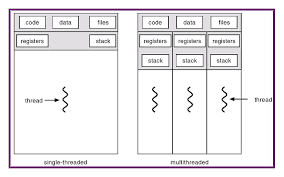Concepts of Threads:
A process is divided into number of lightweight process. Each light weight process is said to be a
thread. The thread has a program counter
that keeps the track of which instruction to execute next, it has a registers,
which holds its current working variables.
It has a stack which contains the execution history.
Number of threads can share an address space, open files and
other resources. Same as a number of processes can share their physical memory,
disks, printers and other resources. Threads operates in many respects in the
same manner as process as they have some of the properties of process.
Threads can be in one of several states: Ready, Blocked, Running
Terminated. Like process, threads share
the CPU, and only one thread at a time is active or running. Threads can create
a child threads. Unlike process, threads are not independent of one another. As
all threads can access every address in the stack; a thread can read or write
over any other thread stacks.
The programmer specifies that application contain ‘Threads of
execution’. It describes each thread designating portion of program that may be
executed concurrently with other threads. This capability is called multi-threading.
Life cycle of Thread:
A thread is
said to be in one of the following several thread states:
·
Born
state: a thread has just been created.
·
Ready
state: the thread is waiting for CPU.
·
Running
state: the system assigns the processor
to the thread.
·
Blocked
state: the thread is waiting for an
event to occur or waiting for an IO device.
·
Sleep
state: sleeping thread becomes ready after the designated sleep time expires.
·
Dead
or Terminated state: the thread has finished its execution.
Multi-threading:
A process is divided into a number of smaller tasks; each
task is called a thread. Number of threads within a process execute at a time. This
is called as multi-threading. Supporting
of multithreading is the additional capability of an operating system. Based on
the functionality, threads are divided into four categories. These are:
1. One Process One Thread:
It is a traditional approach in which the process maintains
only one thread. Hence, it is called single thread approach. For ex: MS DOS
operating system supports this type of approach.
2. One Process, Multiple Threads:
In this approach, a process is divided into a number of
threads. Best example for this is a Java Runtime Environment (JRE).
3. Multiple Process, One Thread Per Process:
An OS supports multiple user processes but only support one
thread per process. UNIX is the best example of this.
4.
Multiple Processes, Multiple Threads Per
Process:
In this approach, each process is divided into a number of
threads. For ex: Windows 2000, Sun Solaris and Linux.
Advantages of a thread:
1.
A
thread takes less time to terminate than a process.
2.
It
takes less time to switch between two threads within the same process.
3.
It
takes less time to create a new thread within the process.
4.
Efficient
communication between threads is possible.


No comments:
Post a Comment